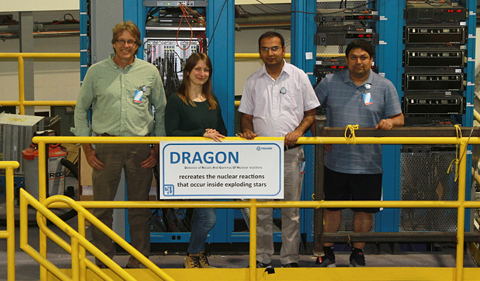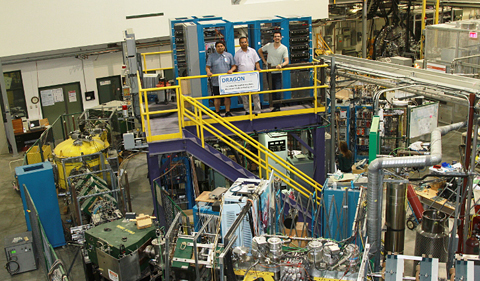
Scientists study stars called red giants to better understand processes such as nuclear fusion—the dominant source of energy for stars in the universe. L to R: Dr. Carl Brune, Dr. Annika Lennarz, a TRIUMF postdoctoral researcher, OHIO doctoral students Som Nath Paneru, and Rikam Giri
By Jean Andrews
Physics & Astronomy
Dr. Carl Brune, Professor of Physics & Astronomy and member of the Institute of Nuclear and Particle Physics (INPP), traveled recently to TRIUMF, Canada’s national lab for nuclear and particle physics, located in Vancouver. With him were his doctoral students Rekam Giri and Som Nath Paneru. The purpose of their visit was to use the DRAGON, a specialized instrument which measures the fusion of helium and carbon — an important process that occurs in red giant stars.
“These measurements will help us to understand where the oxygen in the universe comes from and help to confirm that our models for how stars evolve and produce elements are correct, “ Brune says. “The DRAGON is an ideal instrument for this type of experiment.”
The DRAGON apparatus is used to study nuclear reactions important in astrophysics. By recreating the nuclear reactions that occur inside exploding stars, researchers are better able to understand reactions that produce the chemical elements and energy generation in stars. DRAGON is an acronym for Detector of Recoils And Gammas Of Nuclear reactions.
How Stars Evolve into Red Giants
Brune is particularly interested in energy processes taking place within red giants. These are stars in the last stages of stellar evolution that have exhausted the supply of hydrogen in their cores and have begun thermonuclear fusion of hydrogen in a shell surrounding the core.
“Most stars, including our sun, are burning hydrogen in the cores,” Brune explains. “Once the hydrogen in the core is exhausted, the stars begin to burn helium and become red giants. They expand in diameter and their outer edge is lower in temperature, giving them a reddish-orange hue. Helium is burned by two fusion reactions within a red giant: the fusion of three helium nuclei into carbon and the fusion of helium with carbon to form oxygen.”
The fusion of helium with carbon at this stage is thought to be the main source of oxygen in the universe – even the oxygen on the earth.
The DRAGON instrument at TRIUMF is a recoil separator that is used to detect the oxygen nuclei produced. A carbon beam was used to bombard a helium target. The oxygen nuclei produced by fusion are separated from the carbon beam by the DRAGON instrument and counted.
Brune, Giri, and Paneru are part of a team of nuclear physicists that includes researchers from TRIUMF, the Colorado School of Mines, and Michigan State University. The group convened the week of May 3-10 to run the experiment using the DRAGON.

L to R: Giri and Paneru are joined by Dr. Chris Ruiz, Research Scientist at TRIUMF. The group stands above the DRAGON apparatus, a recoil separator which detects the oxygen produced when the carbon beam strikes the helium target.



















Comments